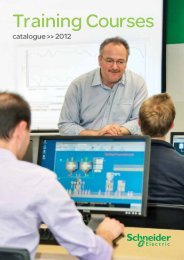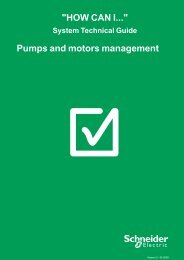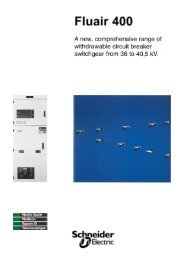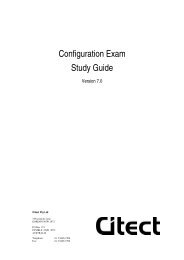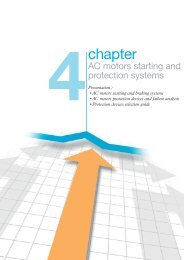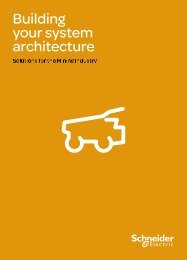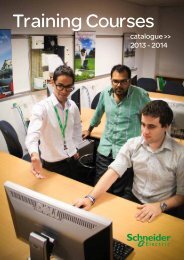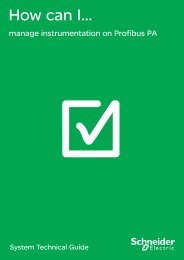Connect - Schneider Electric
Connect - Schneider Electric
Connect - Schneider Electric
You also want an ePaper? Increase the reach of your titles
YUMPU automatically turns print PDFs into web optimized ePapers that Google loves.
3 CORPORATE GOVERNANCE<br />
INTERNAL CONTROL AND RISK MANAGEMENT<br />
10.5 Control procedures<br />
This section describes specifi c measures taken in 2011 to improve<br />
the Group’s control system.<br />
Operating units<br />
For internal control to be effective, everyone involved must<br />
understand and continuously implement the Group’s general<br />
guidelines and the Key Internal Controls.<br />
Training in Key Internal Controls continued in 2011 for those<br />
involved for the fi rst time in the annual self-evaluation process: newly<br />
promoted managers and entities recently integrated. Operational<br />
units, trained by their line management undertook self-evaluation<br />
of compliance with the Key Internal Controls governing their scope<br />
of operations.<br />
The self-assessments conducted during the 2011 campaign<br />
covered 90% of consolidated revenue and made it possible to<br />
defi ne improvement plans in the operating units, when necessary.<br />
The ultimate goal is that these evaluations should cover at least<br />
90% of consolidated revenue each year.<br />
The self-assessments are conducted in the units by each process<br />
manager. Practices corresponding to the Key Internal Controls are<br />
described and performance is rated on a scale of 1 (non- compliance)<br />
to 4 (very good).<br />
For all responses below 3 (compliance) on the scale, an action plan<br />
is defi ned and implemented to achieve compliance. These action<br />
plans are listed in the self-assessment report.<br />
The unit’s fi nancial manager conducts a critical review of the<br />
self- assessments by process, and certifi es the quality of the overall<br />
results. The self-evaluation is then also certifi ed by the person in<br />
charge of the unit.<br />
Operating Divisions and business<br />
To control the reliability of the fi nancial statements and the<br />
alignment of performance with set targets, the Group relies on<br />
Senior Management’s quarterly review process and procedures<br />
carried out by the Management Control and Accounting Unit to<br />
control the quality of accounting data provided by consolidated<br />
units (see “Internal Control organisation and Management – Senior<br />
Management” and “Internal control procedures governing the<br />
production and processing of accounting and fi nancial information”).<br />
In 2011, the Operating Divisions continued to provide training for<br />
the operating units on internal control issues and examined and<br />
challenged the self-assessments of internal audits of these units.<br />
After analysing the results, improvement plans were developed<br />
either for certain units or for certain Key Internal Controls at the<br />
Division level.<br />
The regional internal controllers carried out audits on site as to the<br />
reliability of self-assessments of Internal Control and the effi ciency of<br />
the remediation plans put in place as a result of the previous year’s<br />
self-assessments.<br />
138 2011 REGISTRATION DOCUMENT SCHNEIDER ELECTRIC<br />
Global Functions<br />
In 2011, the Global Functions continued to set guidelines, issue<br />
instructions and provide support.<br />
During the year:<br />
• the Company’s processes were mapped and each one assigned<br />
a “process guarantor” sponsored by a member of the Executive<br />
Committee. The key processes for carrying out strategy of<br />
<strong>Schneider</strong> <strong>Electric</strong> are the subject of particular attention so as to<br />
ensure coherence with operational results, IT and organisational<br />
resources employed including coherence with internal<br />
control demands;<br />
• for the two-year period 2010 and 2011, the IT Security Department<br />
carried out 13 audits in units, which gave rise to reports giving<br />
conclusions and recommendations for the managers of the units<br />
audited. The implementation of recommendations by the units<br />
is subject to monitoring. In 2011 particular attention was paid to<br />
R&D centres;<br />
• in addition to on-site audits, the security function in 2011<br />
acquired a new skill known as “penetration testing”. This skill<br />
set allows the vulnerability of websites to be identifi ed and for<br />
remedial measures taken to limit the effects on any future attacks.<br />
Five sites were audited;<br />
• the Management of Solution Risks Department assists project<br />
leaders in risk assessment, the conclusion of contracts for<br />
major projects and organisation of validation meetings before<br />
submitting proposals;<br />
• in 2011, the Security Department headed up the organisation<br />
of a new Group-level crisis room. In addition, by identifying at a<br />
global level certain internal competences specifi c to the area of<br />
investigation, it initiated the creation of a new organisation directly<br />
reporting to the Fraud Committee that will signifi cantly increase<br />
investigation capabilities as regards combatting internal fraud;<br />
• the Corporate Treasury Department continued to roll out its<br />
central payment system developed in 2009 and which today<br />
covers 60 subsidiaries. Roll out will continue in the years to<br />
come. A system of monitoring bank guarantees so as to track<br />
commitments is also under development.<br />
Internal Control Department<br />
Internal Control continued to deploy the Key Internal Controls<br />
– training and requests for self-assessments – throughout the<br />
Operating Divisions, with the scope extended to cover new units:<br />
50% of the defi ciencies identifi ed during the 2010 campaign were<br />
deemed settled in 2011.<br />
New defi ciencies were identifi ed owing to additional Key Internal<br />
Controls, which gave rise to further action plans.<br />
Internal Control self-assessments were received and analysed,<br />
which identifi ed areas needing work in 2012 as part of the process<br />
of continuous improvement.<br />
In addition to the analysis and action plans initiated by the Entities<br />
and Operating Divisions, similar work is being carried out in the<br />
Global Functions. On the basis of the results obtained in their fi eld,<br />
the various functions defi ne and implement improvement actions<br />
as needed.



